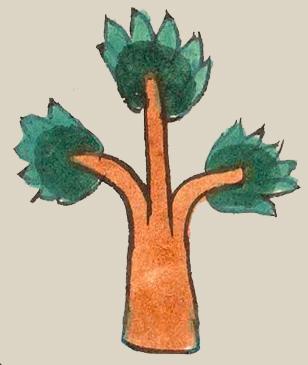huexotl (Mdz26r)
This element has been carved from the compound sign for the place name, Alhuexoyocan. It is a tree with the bark colored orange plus a leader and two branches. The branches have a two-tone green foliage.
Stephanie Wood
The huexotl tree is common in the chinampa zone in the Basin of Mexico, where the trees can live under swampy conditions. Their root mass also helps hold the mud together for growing flowers and vegetables, as explained by a webpage on chinampas hosted by the University of California, San Diego. Because of its central role in fertile agriculture, the white willow was also a prominent element in prophecies, such as the prophecy for the founding of Tenochtitlan, according to Alison Syme's book Willow (2014), where a willow surrounded by a natural spring (as shown in the full glyph for Alhuexoyocan, below right) would be an important indicator of the promised land.
Huexotl is also a person's name. One notable figure with this name died in 1582, but it is still in use today in Mexico. See our online Nahuatl Dictionary for more information.
Stephanie Wood
c. 1541, but by 1553 at the latest
Stephanie Wood
willows, springs, foundation stories

huexo(tl), white willow tree, https://nahuatl.wired-humanities.org/huexotl
white willow
el sauce o el huejote
Stephanie Wood
Codex Mendoza, folio 26 recto, https://digital.bodleian.ox.ac.uk/objects/2fea788e-2aa2-4f08-b6d9-648c00..., image 62 of 188.
The Bodleian Libraries, University of Oxford, hold the original manuscript, the MS. Arch. Selden. A. 1. This image is published here under the UK Creative Commons, “Attribution-NonCommercial-ShareAlike 3.0 License” (CC-BY-NC-SA 3.0).

